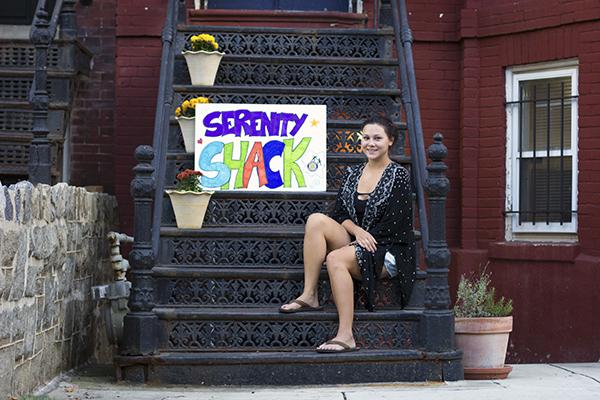Updated: Sept. 10, 2015 at 8:20 p.m.
When Carmen de la Peña Noreña arrived at GW from Spain for her year abroad last year, she had been struggling with depression for so long she considered taking her own life.
But after joining Students for Recovery, a student organization geared toward helping students recover from substance abuse and mental illness, Noreña was able to turn her life around, earning the organization’s Campus Transformer Award before she graduated in the spring and took consistent, small steps to her own recovery.
“Having that space there, where you know you can be yourself and feel safe, knowing that there’s nothing there that will trigger you, is like a breath of fresh air,” she said.
And now, there is a new space for students struggling on campus. Students for Recovery members unveiled a “Serenity Shack” last semester, providing a home for recovering students and offering an area to host events centered on recovery throughout this month.
The Serenity Shack, nestled in the lower level of a townhouse on 22 and F streets, is an open space with couches, tables for studying and a TV that students can gather around for watch parties.
Timothy Rabolt, a former president of SFR, said it took roughly a year to acquire the space and prepare it for use. Administrators like Mark Levine, the senior associate dean of students, and Seth Weinshel, the executive director of housing, were extremely supportive in funding and supporting the townhouse’s redesign, he said.
The organization funded the Serenity Shack using Student Association funding and through donations. The University provided basic furniture and appliances, Rabolt said.
The University awarded the organization the space last year after members laid out a compelling case citing the success stories of students from other campuses across the country.
Where students in recovery programs had access to a space at their discretion and the support of a peer community at institutions including Texas Tech and Rutgers universities, they started to have higher GPAs, were graduating more often and were more likely to pursue master’s degrees, Rabolt said.
“[The students] have a lot of drive to succeed and give back, and when we could show that to President Knapp and Dean Konwerski and other folks, they completely got behind it,” Rabolt said.
Dean of Student Affairs Peter Konwerski said in an email that officials saw the space “as an opportunity to promote health and wellness, while also encouraging our students who may be struggling to seek help.”
He said the space gives students a space to overcome obstacles “in an environment of comfort and support.”
“Students who are in recovery from mental illness or addiction are an often-overlooked student population on many campuses,” he said. “The recovery space that we worked to provide for these students aligns directly with the University mission of furthering human wellbeing and a healthy campus.”
The Serenity Shack was home to this year’s Recovery Month kickoff event, hosting 25 students and others from around D.C. for an introduction to the group and the month’s coming events, which include an open house and a screening of the film “To Write Love on Her Arms,” which tells a true story of drug addiction.
Since the group began in 2012, Students for Recovery has held panels on campus mental health programs and established sober housing and residential accommodations to include recovering students. Rabolt said administrators saw a gap in peer-focused mental health services on campus.
Now, with the Serenity Shack as an established space on campus, Rabolt said the group has made another step toward bridging that gap in resources for students.
“It’s turned into a safe haven. It’s really like a home that’s taken a life of its own,” Rabolt said.
The University has increased mental health resources in recent years. The University Counseling Center hired eight specialized counselors last year and was one of three departments to see budget increases amid University-wide cuts. Peer counseling was a priority for last year’s Student Association executive administration, and this year’s SA President Andie Dowd has said she will continue with that effort. A portion of this fall’s tuition increase will also go toward mental health services on campus.
Jennifer Curt, a junior who joined Students for Recovery her freshman year, said the Serenity Shack “brings together people that can help each other.” She said more students have shown an interest in the group since the Serenity Shack opened.
“I can help others, and others can help me,” Curt said.
For Curt, regardless of what other people are in recovery from, the Serenity Shack is a place where everyone can be themselves. It’s a space where students can support each other after reflecting on their own experiences.
“Being able to pass it on and help others, that’s something that’s really important for my recovery,” she said.








